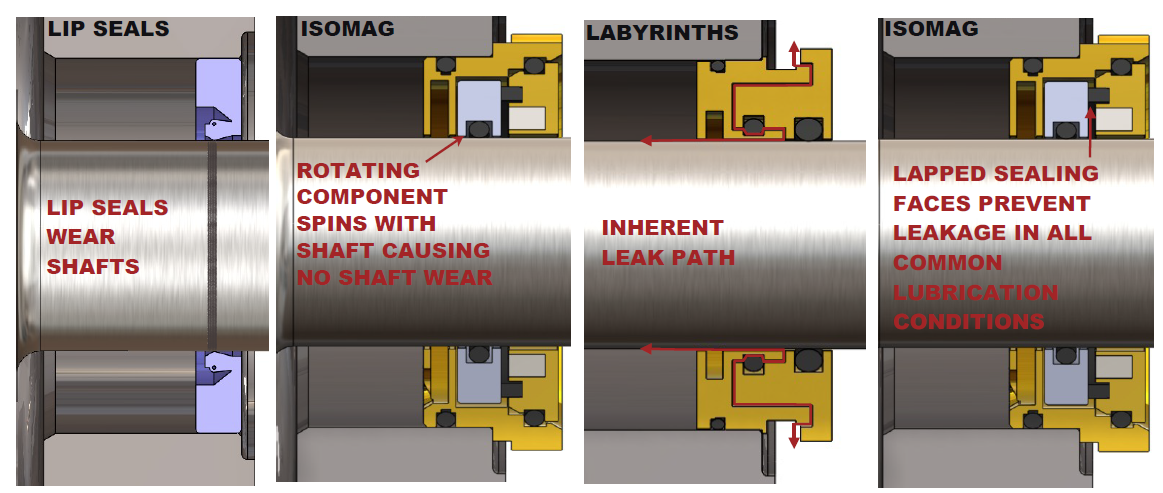Bearing Protector Selection Criteria
Below is a comparison of bearing protector / bearing isolator technologies on ten key selection criteria to consider when deciding which bearing protector / bearing isolator is the best choice for plant-wide use in all types of rotating equipment and all types of bearing lubrication methods.

Figure 1: Comparison between lip seals to Isomag bearing isolators and labyrinth devices to Isomag bearing isolators.
1.) Performs reliably in grease, splash oil, circulated oil, bath oil level, submerged/flooded oil level and oil mist.
IsoMag bearing isolators: Utilize a lapped flat face designed to seal liquid and vapor in operation or stand-by with an operating life of 100,000 hours at 12,000 fpm (60 mps) and zero increase in bearing temperature.
Labyrinth devices: most dual path labyrinth devices rely on some type of o-ring, lip-seal contacting device and/or stuffed micro fiber in order to seal. These devices can be subject to the short operating life limitations of the lip seals they are replacing.
2.) Performs reliably in static and/or dynamic conditions.
IsoMag bearing isolators: Utilize a lapped flat face designed to seal liquid and vapor in operation or stand-by with an operating life of 100,000 hours at 12,000 fpm (60 mps) and zero increase in bearing temperature.
Labyrinth devices: most dual path labyrinth devices rely on some type of o-ring, lip-seal contacting device and/or stuffed micro fiber in order to seal. These devices can be subject to the short operating life limitations of the lip seals they are replacing.
3.) Performs reliably in horizontal, vertical and heavy sea positions.
IsoMag bearing isolators: are a sealing device that provides a positive seal in all positions: horizontal, vertical and rolling side to side.
Labyrinth devices: are restriction devices that are equipped with an o-ring or lip seal to convert them to a sealing device. The o-rings and lip seals are usually an elastomer or a PTFE material running against a metal stationary service – it is well established that flat face seals with high wear resistant and low coefficient of friction face materials are superior sealing devices in dynamic conditions at the rotational speeds of many pumps, gearboxes, steam turbines and other industrial rotating equipment.
4.) Provides a reliable liquid tight seal.
IsoMag bearing isolators: Utilize a lapped flat face designed to seal liquid and vapor in operation or stand-by with an operating life of 100,000 hours at 12,000 fpm (60 mps) and zero increase in bearing temperature.
Labyrinth devices: most dual path labyrinth devices rely on some type of o-ring, lip-seal contacting device and/or stuffed micro fiber in order to seal. These devices can be subject to the short operating life limitations of the lip seals they are replacing.
5.) Allows air egress:
IsoMag bearing isolators and Labyrinth devices: both allow air egress. The lapped flat face of the IsoMag seal prevents liquid leakage but a gas can pass across the face.
6.) Prevents stray oil mist:
In side-by-side comparisons the leakage of stray oil mist past labyrinth devices is clearly visible while there is no visible leakage past the IsoMag seal.
7.) Performs reliably in vented and non-vented conditions:
IsoMag bearing isolators: The IsoMag bearing isolator allows air egress across its face due to a slight positive pressure differential but since there is no pressure differential during stand-by conditions the IsoMag seal does not allow moisture ingress in vented applications.
Labyrinth devices: most dual path labyrinth devices rely on some type of o-ring, lip-seal contacting device and/or stuffed micro fiber in order to seal. The o-ring and lip seals can be subject to the short operating life limitations of the lip seals they are replacing. When the sealing element becomes worn the labyrinth is only a restriction device and therefore allows the ingress of moisture during stand-by conditions in vented applications.
8.) May not use any host equipment component as a dynamic sliding sealing surface.
IsoMag bearing isolators and the labyrinth devices: both technologies meet this criterion but conventional lip seals and oil seals do not. Conventional lip seals and oil seals use the equipment shaft or sleeve as a wearing surface.
9.) All wearing components must be contained within the seal or isolator.
IsoMag bearing isolators and the labyrinth devices: both technologies meet this criterion but conventional lip seals and oil seals do not. Conventional lip seals and oil seals use the equipment shaft or sleeve as a wearing surface and therefore causes wear of those components, which can be difficult and expensive to replace. Although not normally used as a bearing lubrication sealing device, certain designs of mechanical seals can have a wearing component that is external to the seal.
10.) Performs reliably at or below the host equipment operating bearing temperature.
IsoMag bearing isolators: The IsoMag face materials and face loading are engineered to be highly wear resistant while creating virtually no seal face generated heat.
Labyrinth devices: generally do not generate significant heat but also do not have high wear resistance in many applications and therefore become restriction devices in a relatively short period of operating hours and not seals. Restriction devices generally are not as effective in preventing ingress of contamination and/or egress of bearing lubrication.
For more information on how bearing isolators can improve the MTBR or your equipment, contact customerservice@isomag.com and a sales representative will get back to you shortly.